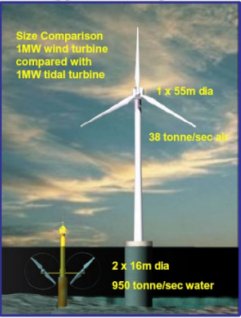


| Why Marine Currents? |  |
Market drivers Energy yield Not tidal barrage Technology status
Comparison with other sources References
Market drivers
There are a number of market drivers making marine currents a more viable renewable alternative to traditional energy sources:
- The world-wide demand for electricity is expected to double within the next 20 years,
with the strongest growth in the developing areas of Asia.
- The decommissioning of nuclear power stations and an increased reliance upon natural
gas resulting in concerns over security of supply and an increased push for renewables.
- The introduction of the EC emissions trading scheme making renewables an attractive
investment.
"Wave and tidal power have huge potential to supply a significant proportion of the countryís future energy needs. Britain is already a world-leader in this technology. However, it is essential that we move from the research and development phase, which has been going on for many years, into commercial application.
The potential for such devices in the UK is significant but it also important to remember that there is going to be a global demand for proven technologies and we are well placed to capture this market once they are operating successfully in the UK. Success in projects of this sort will further the commercial development of wave and tidal energy and could lead to the creation of a major industrial sector with export potential."
back to top
Energy yield

Marine current energy is a particularly attractive renewable energy source. The velocities in good tidal stream areas are a fraction of typical wind cut-out speeds, but they are steadier and accurately predictable. This means there should be less need of storage and easier integration within network planning.
In addition, the increased density of water in comparison to air means that it has higher energy intensity than most renewables (four times as much as wind).
This means that marine turbines can be much smaller than wind turbines, as shown on the left.
back to top
Not tidal barrage!
It should be stressed that marine current or tidal stream technology is not the same as tidal barrage technology. Tidal barrage projects such as the proposed Severn Barrage project have a number of disadvantages, that marine current technology does not have:
- Very high capital costs (between £10-15bn plus financing)
- Production of huge slabs of power which would disrupt the power system both technically and economically (grid strengthening and market prices)
- Long installation time before operation possible - potentially 10 years before the installation can be fully operational.
- Environmental issues - altering the flow in an estuary system has an adverse impact on the abundant marine life in such an area
back to top
Technology status
Turbines have been built in a number of countries. Currently, there are no commercial schemes world-wide, but a demonstration project is being implemented on the Devon coast, and another in Norway, with one planned in Shetland. A number of relevant projects are listed in the table below
| Location | Company/Uni | Project title | Project details |
| Lynmouth Coast, Devon | MCT/Peter Fraenkel | Seaflow | UKís first permanent marine current turbine to generate electricity, £3m, 11m blade, 300kW rated. Funds: DTI £960,000, EC£1m |
| Kvalsund, Norway | Hammerfest StrÝm/Statoil/ABB | Blue | First grid connected marine current turbine. |
| Italy, Straight of Messina | ENERMAR | Late 1990s, 130kW, crossflow Kobold turbine, max efficiency 42% | |
| Yell Sound, Shetlands | Engineering Business | Stingray | 150kW, Wing design |
| Loch Linnhe | IT Power | 15kW moored, rotor suspended from floating buoy. In full operation would be anchored to the seabed by cables. | |
| Orkney | Robert Gordon University / Prof. Bryden / AREG | SeaSnail | 150kW, 30 tonne, £200,000 Scottish Enterprise funding |
| Bluemull Sound, between islands of Yell and Unst, Shetlands | Seapower Scotland / Delta Marine | Exim | Ship-based prototype to measure energy produced at diff sites to find best site for full-scale tidal generator station for Shetland grid. £13,000 funding Shetland Enterprise / Islands Council. |
| Grimsby/Iceland/Shetlands | RVco | Rochester/Hydro Venturi | Uses tidal flow to draw working fluid through turbines mounted onshore - hence has no moving parts under water. Expected to enter large-scale demonstration soon- commercial power station to be built in Iceland. |
Comparison with other sources
The advantages of marine current energy over other renewables can be clearly observed in the table below, although actual characteristics will vary according to generator design. One of the major drawbacks of this technology however, is the high capital cost, as technology is in itís infancy.

back to top
References
-
Emily Rudkin, Vortec Energy Ltd (post 2001), Survey of Energy Resources - Marine Current Energy, World Energy Council at:
http://www.worldenergy.org/wec-geis/publications/reports/ser/marine/marine.asp - Department of Trade and Industry, article on the Severn Barrage,
http://www.dti.gov.uk/energy/renewables/policy/waveandtidal.pdf - Network for Alternative Technology and Technology Assessment (September 2001), article on Marine Energy,
Renew On Line (UK) 33, Sept-October 2001 edition, The Open University.
http://www-tec.open.ac.uk/eeru/natta/renewonline/rol33/8.html -
Open University Energy and Environment Research Unit, (January 2001), Appendix 6 - Memorandum submitted to Select Committee on Science and Technology (Appendices to the Minutes of Evidence), HMSO.
http://www.parliament.the-stationery-office.co.uk/pa/cm200001/cmselect/cmsctech/291/291ap07.htm
-
Gordon Feller (2002), Wind, waves and tides - Economically Viable Energy from the World's Oceans, EcoWorld.
http://www.ecoworld.org/Home/articles2.cfm?TID=334 -
Speech Given By UK Energy Minister Brian Wilson (21 March 2003), Renewables Conference, Stornoway.
http://www.w-isles.gov.uk/energy/press34.htm
back to top